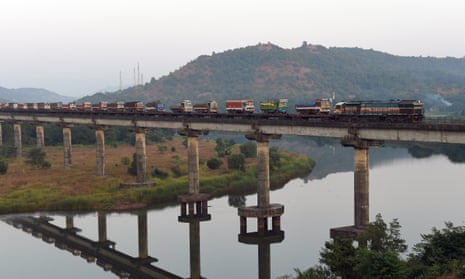India’s growth in emissions could tip the world over the threshold to dangerous climate change, experts have said.
The alert comes as the Indian prime minister, Narendra Modi, prepares to visit the UK on Thursday for talks on issues including the environment.
India is due to ask the UK and other rich nations to share breakthroughs in renewable energy and other “clean” technology, and for help financing a huge expansion in efficiency and solar and wind power. It is unclear whether British officials will pressure Modi to consider a tougher emissions target.
Before the UN climate summit in Paris in December, India has pledged to increase carbon and other greenhouse gas emissions more slowly than the economy grows. The latest analysis of India’s plan calculates that if it expands as it hopes – by more than 8.5% a year – emissions will reach 9bn megatonnes by the end of the next decade.
This is about one-fifth of the total annual emissions that scientists calculate the world can emit in 2030 and still have a more than a 50% chance of avoiding the global temperature rising more than 2C, considered a dangerous threshold. Although India would rank second behind China for total emissions, unlike China and other large emitters it has not set a date by which they would peak, while new coal-fired power and other new infrastructure would commit the country to relatively high pollution levels for decades.
“If India’s plans to burn coal go ahead, it will make it hard for us to make the two degree target,” said Bob Ward, policy director of the Grantham institute on climate change and the environment, at the London School of Economics, which carried out the study. “The chances are growth will be lower, but it’s hard to imagine we’ll get down to a pattern consistent with two degrees.”
Further pressure has been put on India by the International Energy Agency, which on Tuesday published it’s annual report on global energy use, and considered the Indian case to be so critical that it devoted several chapters to the country’s rapidly rising use of coal and oil in particular. “Meeting India’s energy needs requires … constant vigilance as to the implications for energy security and the environment,” the IEA said.
Although India has so far failed to meet its hopes for growth, its population is expected to rise from 1.2 billion to 1.5 billion by the middle of this century – overtaking China as the world’s largest – and it is pursuing aggressive expansion of industry and energy production to lift an estimated 300 million people out of poverty.
“It is estimated that more than half of [the] India of 2030 is yet to be built,” the government has said, citing “exponential” growth in demand for housing, energy, transport, water and waste disposal. The risks posed by India’s rapid growth are at the heart of ongoing tension between rich and poor nations, with developing and emerging economies arguing that countries that have already become rich on fossil fuel energy should make deeper cuts in emissions rather than curb poorer countries’ growth.
India’s emissions per person are 1.7 metric tons a year, compared with nearly 17t in the US and more than 7t in both China and the European Union.
“India’s argument is that they have development challenges which must take priority, and currently the cheapest route to development is through high-carbon infrastructure,” said Diarmuid Torney, author of a new book on China and India’s climate policies. “They don’t have time to wait for the cost of renewable energy to fall
“But if India’s emissions increase at the projected rate and developed country emissions don’t decline rapidly over the short to medium term, then the maths does get us into trouble.”
Climate Action Tracker, which has analysed 26 emissions pledges covering 53 countries (including the EU) ahead of the UN-hosted Paris meeting (these account for 80% of the global total) estimates that India’s emissions would reach about 5bn tonnes, based on lower external forecasts of the country’s growth.
India has made a potentially more ambitious promise to generate 40% of electricity from renewable sources – including nuclear power – by 2030, but this depends on external help.
Alongside the US, EU and China, Cat ranks India’s plans as “medium”. It adds: “It is not consistent with limiting warming to below 2C, unless other countries make much deeper reductions and comparably greater effort.”






Comments (…)
Sign in or create your Guardian account to join the discussion